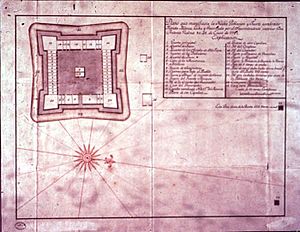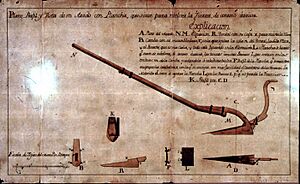Floridablanca (Patagonia) facts for kids
Imagine a small Spanish town built a long time ago, in 1780. It was called Nueva Colonia y Fuerte de Floridablanca. This town was located in San Julian Bay, a place in what is now Santa Cruz Province, Argentina. Sadly, after only four years, everyone had to leave. Many people got sick with a disease called scurvy, which made them very weak. Before leaving, they even destroyed the buildings so that no other countries could use them.
Today, Floridablanca is not a town anymore. It's an archaeological site. This means scientists study the old remains to learn about the people who lived there. It is found near Port San Julian in Santa Cruz Province, Argentina.
History of Floridablanca
The small town of Nueva Colonia y Fuerte de Floridablanca was started as part of a big plan. King Charles III of Spain wanted to settle the Atlantic coast of Patagonia in the late 1700s. This was a smart move by Spain to claim and explore parts of its empire that were empty or unknown.
The settlement had about 150 people. It was named after the Count of Florida-Blanca, who was the chief minister (like a prime minister) for the king at that time.
In Floridablanca, new ideas from the Spanish Enlightenment were put into action. This was a time when people focused on reason and new ways of thinking. The main ideas for the colony were farming and strong families. Farming was chosen as the best way for the town to support itself. They tried to make sure farming would grow by creating a society where families worked the land.
Families were seen as the most important part of society. The Spanish King made sure these families had what they needed. This included places to live, food, healthcare, land, seeds, and tools for farming.
Studying Floridablanca's Past
Floridablanca is now a very important place for scientists. A research project called "Archaeology and History at the Spanish colony of Floridablanca (Patagonia, 18th century)" studies the site. This project is led by Dr. María Ximena Senatore. She works with the Instituto Multidisciplinario de Historia y Ciencias Humanas, CONICET, and the University of Buenos Aires in Argentina.
These researchers dig up and study old objects and structures. They learn about how people lived in Floridablanca long ago. This helps us understand the history of the Spanish colonies in Patagonia.
See also
 In Spanish: Nueva Colonia y Fuerte de Floridablanca para niños
In Spanish: Nueva Colonia y Fuerte de Floridablanca para niños
- Nombre de Jesús (Patagonia)
- Carmen de Patagones



